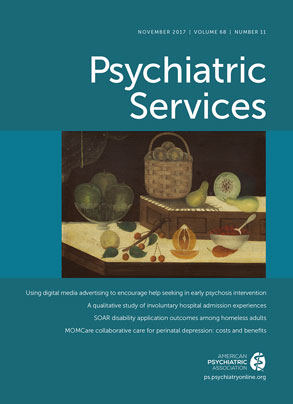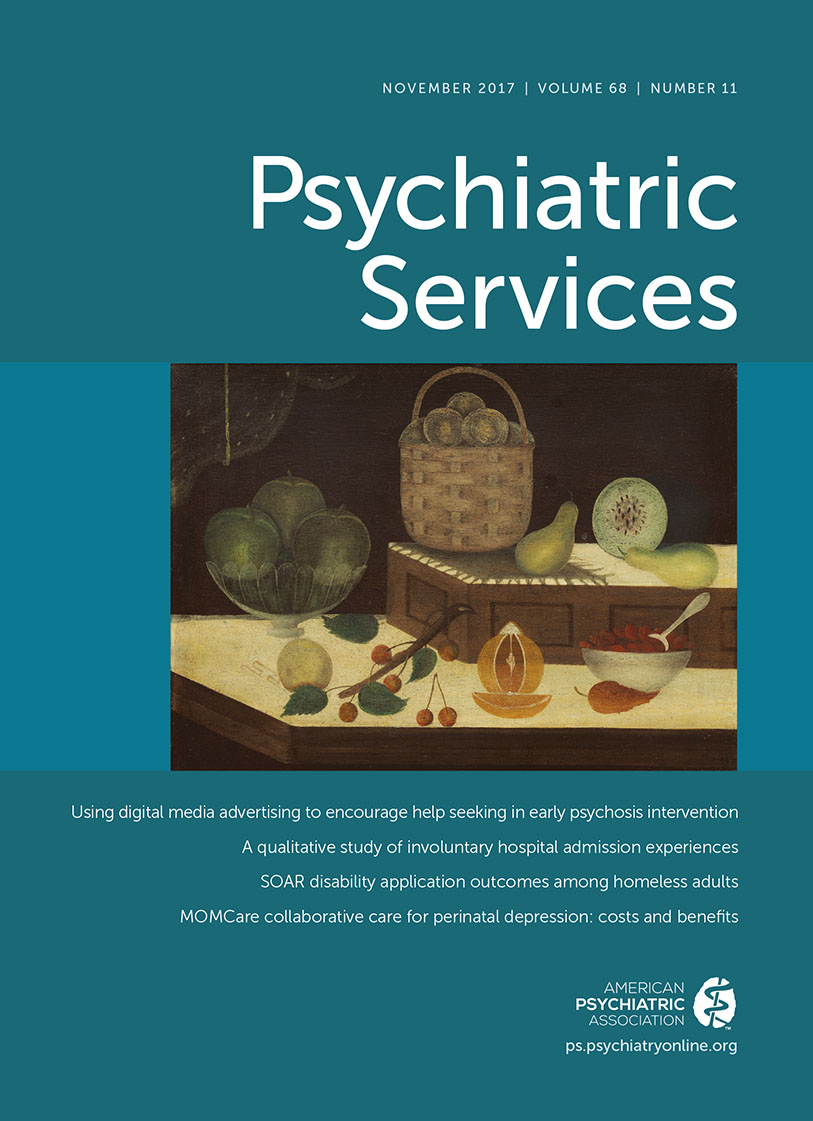One in four Americans has a mental health or substance use problem. These conditions account for 20% of primary care visits (
1) and in 2005 cost the United States $135 billion (
2). Yet over half of adults who need behavioral health (BH) services (covering mental health and substance use services) do not receive them (
3). Evidence suggests that integrating primary care and BH care can improve care access and outcomes (
4–
6).
Integrated care models range from distant collaboration, to physical colocation, to truly integrated care wherein one team addresses general medical needs and behavioral health. The way in which integration is achieved varies (
7); primary care can be folded into BH centers (
8), or BH services can be added to primary care centers. Another way BH services are incorporated is to use computer-assisted cognitive-behavioral therapy (cCBT) as a first-line treatment for depression, alcohol use (
9), and other complaints (
10).
This column focuses on the addition of BH services to primary care centers. A comprehensive integrated BH model, funded by the Nicholson Foundation, was implemented in two New Jersey federally qualified health centers (FQHCs). Project goals included universal BH screening (for depression, anxiety, substance use, insomnia, and obsessive-compulsive disorder), brief behavioral interventions based on primary care provider (PCP) referrals or positive screens, cCBT for patients with positive BH screens, and referrals for patients requiring a higher level of psychiatric care.
The Two Sites
Although both clinics are located in New Jersey, they differ in size, patient population, organizational structure, and culture (
Table 1).
Trenton, New Jersey.
One in four of Trenton’s nearly 85,000 inhabitants live in poverty (
11), and high rates of chronic disease confront care providers. Much of the city’s primary care is provided by the Henry J. Austin Health Center (HJAHC), an FQHC with 60,000 visits each year. At HJAHC, 6% have private insurance, 30% are uninsured, and the remainder have public insurance of some kind. Before the rollout of the integrated BH model, BH care was provided by contract employees, including a part-time psychiatrist, full-time advanced practice registered nurse (APRN), and full-time licensed clinical social worker (LCSW). Patients were referred by PCPs; routine screening was not performed. On average, patients waited two weeks for an appointment with the LCSW or APRN, a month and a half for the psychiatrist, and over three months for outside referrals to psychiatrists.
Lakewood, New Jersey.
Lakewood’s demographic makeup differs markedly from Trenton’s, with 6% of its patients being African American, 17% Hispanic, and 67% Caucasian, a large proportion of which is Orthodox Jewish. A major health care provider is the Center for Health Education, Medicine, and Dentistry (CHEMED) FQHC. Its population consists of 58% publicly insured, 32% privately insured, and 10% uninsured patients. Before the integrated care rollout, BH services were provided by a team of LCSWs and on-site counselors; patients were referred by primary care providers. Waits for BH services were shorter than at HJAHC. Patients could not always be seen immediately by the BH team, though, which contributed to a relatively high no-show rate at follow-up visits and referrals. No psychiatrist was on staff, but patients could be referred for outpatient psychiatric treatment.
Integration
Model.
The pilot replicated Cherokee Health System’s (CHS’s) model of integrated care (
12). The CHS model integrates care by embedding a behavioral health consultant (BHC), usually an LCSW or psychologist, in a primary care team. BH services are available for chronic disease management (such as psychoeducation, weight loss, and diabetes management tips) and for management of psychiatric disorders; most behavioral assessments and interventions happen during the same-day primary care visits. Compared with other regional providers, patients enrolled in CHS’s integrated clinics have lower overall costs, lower specialist utilization, and fewer hospital visits (
8). The New Jersey model also incorporated Cobalt Therapeutics’ cCBT programs.
Barriers.
These clinics illustrate the complex barriers that integrated care projects must navigate. Barriers have been outlined in detail elsewhere (
13) but, briefly, include a mental health culture that lacks screening for general medical issues and works with carve-out models of public-sector funding, and lacks accreditation policies or enforcement that rewards integrated care. In our case, existing FQHCs chose to add BH services via BHCs and cCBT by using a proven model of integrated care from CHS. But this was only the beginning. Each clinic had different structures and cultures, requiring slightly different personnel hires, and different ways of folding screening tools and BHCs into clinic workflow. In New Jersey, licensure regulations discourage housing BH and primary care in the same health center. And payment was sometimes declined by Medicaid or private insurance if BH and primary care services were provided on the same day. This incentivized patients to schedule a separate BH appointment and precluded a “warm hand-off” from primary care to BH care.
Staffing considerations.
At each site, a BHC (at HJAHC an LCSW; at CHEMED a psychologist and later an LCSW) at 1.0 full-time equivalent (FTE) was hired for a primary care team and began by attending a two-day training at CHS in Tennessee. BHCs for other primary care teams were hired after the initial rollout period. At HJAHC, BHCs with experience working with an underserved population were hired, whereas at CHEMED, cultural sensitivity and experience working with an Orthodox Jewish population were needed. Both FQHCs contracted with a full-time APRN for medication management. At HJAHC, a psychiatrist was also hired for 10 hours weekly to provide psychiatric consultations when requested by staff (hours varied). A quality improvement assistant was hired at .2 FTE (from an existing employee’s time) to ensure proper data collection and documentation.
The primary care team staff (BHC, PCP, RN, medical assistant, receptionist, and support staff) attended a full-day integrated care training session led by CHS. Staff members who would be screening and referring patients to cCBT (completed on a patient’s own time) attended several training sessions with Cobalt Therapeutics.
Clinic setup and workflow.
Electronic medical records (EMRs) were updated to accommodate screening questions and allow BHCs to document encounters. Similarly, billing processes were modified to account for BHC visits, with the goal that each site could continue offering integrated care after foundation funding ended. One room at each site was outfitted with a computer, printer, and comfortable space for patients to use Cobalt’s cCBT software.
The clinic workflow was adjusted to accommodate the BHC and universal screening. At both clinics, the BHC joined the morning primary care team huddle (a brief daily meeting where clinic staff discuss scheduled patients) to help determine which patients warranted evaluation. At HJAHC, the medical assistant testing vital signs administered BH screens, the results of which were documented in the EMR. At CHEMED, patients were given a tablet with a computerized screening tool to complete while waiting. Results were available to PCPs immediately. In almost all cases, a patient who screened positive for a BH issue or elicited concern in the morning huddle was seen by a BHC the same day.
Each BHC encounter involves a brief assessment (10–20 minutes). It focuses on behavioral interventions and actionable steps that patients can take before their next appointment. Using screening data, consultation with the PCP, and a clinical interview, the BHC determines which patients will benefit from brief interventions, cCBT, or a higher level of care.
Lessons Learned and Next Steps
Using generous private foundation grants, two New Jersey FQHCs made substantial progress toward implementing an integrated care model in one year’s time. Perhaps most striking is that changes had to be made everywhere, from the clinic’s physical space, to training and hiring practices, to information technology and billing, to patient check-in procedures and appointment flow. Strong leadership from clinic staff and a proven integration model were critical to overcoming the separation between BH and primary care. Each site tailored the model by hiring BHCs suited to their unique populations and by incorporating screening tools into their workflow to suit their clinic and patients’ needs. Each clinic needed not only to understand general principles of care integration and navigate local regulatory and reimbursement landscapes but also to understand their own clinic’s patient population, culture, and workflow well enough to make sustainable changes.
Ongoing goals are to provide a self-sustaining framework for integrated care and to continually improve quality and processes. Future reports will analyze the impact of these initiatives on clinic structure, care access, cost, and outcomes.
Acknowledgments
This work was funded by a grant from the Nicholson Foundation.

